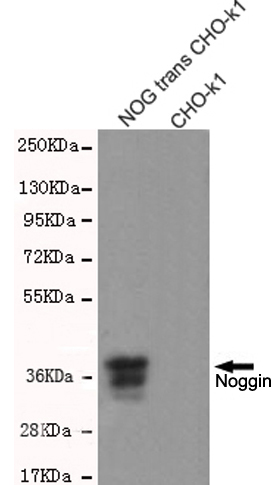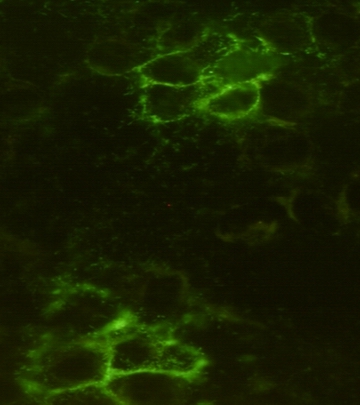- Home
- About
- Promotions
-
Products
-
Elisa Kits
- |
-
Primary antibodies
- |
-
Secondary antibodies
- |
-
Proteins
- |
-
IHC reagents
- |
-
WB reagents
- PonceauS Staining Solution
- PBST Washing Buffer, 10X
- 1.5M Tris-HCl Buffer, pH8.8
- 1M Tris-HCl Buffer, pH6.8
- 10% SDS Solution
- Prestained Protein Marker
- TBST Washing Buffer, 10X
- SDS PAGE Loading Buffer, 5X
- Stripping Buffered Solution
- Tris Buffer, pH7.4, 10X
- Total Protein Extraction Kit
- Running Buffer, 10X
- Transfer Buffer, 10X
- 30% Acr-Bis(29:1) Solution
- Tris电泳液速溶颗粒
- PBS(1X, premixed powder)
- TBS(1X, premixed powder)
- 快速封闭液
- 转膜液速溶颗粒
- Chemical reagents
- News
- Distributor
- Resources
- Contact
- Home
- >
- Info
- >
- Noggin mouse mAb
- >
- Go Back
Noggin mouse mAb
- Catalog No.:YM1365
- Applications:WB;ICC
- Fields:
- >>TGF-beta signaling pathway
- Immunogen:
- Purified recombinant human Noggin protein fragments expressed in E.coli.
- Specificity:
- Transfected Only.
- Formulation:
- Liquid in PBS containing 50% glycerol, 0.5% BSA and 0.02% sodium azide.
- Source:
- Monoclonal, Mouse
- Dilution:
- wb 1:1000 icc 1:100
- Purification:
- The antibody was affinity-purified from mouse ascites by affinity-chromatography using epitope-specific immunogen.
- Storage Stability:
- -15°C to -25°C/1 year(Do not lower than -25°C)
- Other Name:
- NOG;NOGG_HUMAN;Noggin;SYM 1;SYM1;Symphalangism 1 (proximal);Synostoses (multiple) syndrome 1;SYNS 1;SYNS1.
- Background:
- The secreted polypeptide, encoded by this gene, binds and inactivates members of the transforming growth factor-beta (TGF-beta) superfamily signaling proteins, such as bone morphogenetic protein-4 (BMP4). By diffusing through extracellular matrices more efficiently than members of the TGF-beta superfamily, this protein may have a principal role in creating morphogenic gradients. The protein appears to have pleiotropic effect, both early in development as well as in later stages. It was originally isolated from Xenopus based on its ability to restore normal dorsal-ventral body axis in embryos that had been artificially ventralized by UV treatment. The results of the mouse knockout of the ortholog suggest that it is involved in numerous developmental processes, such as neural tube fusion and joint formation. Recently, several dominant human NOG mutations in unrelated families with proximal symphalangism (SYM1) and mu
- Function:
- disease:Defects in NOG are a cause of stapes ankylosis with broad thumb and toes [MIM:184460]. Stapes ankylosis with broad thumb and toes is a congenital autosomal dominant disorder that includes hyperopia, a hemicylindrical nose, broad thumbs, great toes, and other minor skeletal anomalies but lacked carpal and tarsal fusion and symphalangism.,disease:Defects in NOG are a cause of symphalangism proximal syndrome (SYM1) [MIM:185800]. SYM1 is characterized by the hereditary absence of the proximal interphalangeal (PIP) joints (Cushing symphalangism). Severity of PIP joint involvement diminishes towards the radial side. Distal interphalangeal joints are less frequently involved and metacarpophalangeal joints are rarely affected whereas carpal bone malformation and fusion are common. In the lower extremities, tarsal bone coalition is common. Conducive hearing loss is seen and is due to fusi
- Subcellular Location:
- Secreted.
- Expression:
- Placenta,Prostate,Temporal cortex,

- Western blot detection of Noggin in CHO-K1 cell lysates over-expressing Noggin-PDGFR transmembrane domain fused protein using Noggin mouse mAb (1:1000 diluted).Predicted band size:26KDa.Observed band size:37KDa.

- Immunocytochemistry staining of HeLa cells surface-expressing Noggin-PDGFR transmembrane domain fused protein using Noggin mouse mAb (dilution 1:100).





